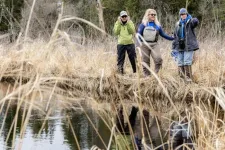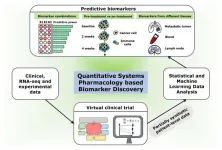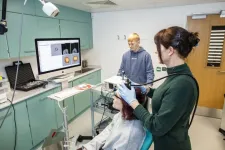(Press-News.org) Lifetime cannabis use is associated with several changes in brain structure and function in later life, suggests an observational study, but these associations may not be causal, finds a genetic analysis of the same data, published in the open access journal BMJ Mental Health.
Some other unidentified factors may explain the differences found, say the researchers, who nevertheless emphasise that further research is needed to fully understand the effects of heavy use and cannabis potency on the brain.
Cannabis use has increased worldwide following its legalisation for medical and recreational purposes. But this has happened in the absence of a thorough understanding of its potential long term effects on the brain, say the researchers.
Its use is associated with deleterious effects on neurocognitive performance, brain structure, and function. And it’s not known if there is a safe threshold, they add.
But previously published observational studies have not been able to confirm that cannabis caused the changes seen among regular users of the drug, and few of these studies have included older people.
In a bid to strengthen the evidence base, the researchers used Mendelian randomisation, a technique that uses genetic variants as proxies for a particular risk factor—in this case cannabis use or dependence—to obtain genetic evidence in support of a particular outcome—in this study brain structure among older lifetime users.
They drew on 15,896 cannabis users participating in the UK Biobank for whom genetic profiling (2012-13) and brain imaging (MRI scans) (2014-19) data were available.
Participants reported if they had ‘ever taken cannabis’, with response options ranging from once or twice to more than 100 times.
All participants who responded ‘yes’ were categorised as lifetime cannabis users (3641; average age 61), with ‘no’ responders categorised as the comparison group (12,225; average age 64).
Cannabis users were further divided into low frequency users, defined as lifetime cannabis use of up to 10 times, and high frequency users defined as lifetime use of 11–100+ times. Participants also reported how old they were when they last used the drug.
The researchers accounted for a range of potentially influential factors, including: age at first scan (in years), sex, and age-by-sex interaction; level of deprivation; employment status; qualifications; smoking and alcohol consumption; blood pressure; weight (BMI); mental state; and 613 brain imaging-related variables.
After adjusting for these factors, cannabis use was associated with multiple measures of changes in brain structure and function.
Participants who had ever used cannabis had poorer white matter integrity, a constituent of the brain that is important for cognitive function. And this was particularly evident in the corpus callosum, the main route of communication between the left and right sides of the brain.
Cannabis users also had weaker resting state neuronal connectivity in brain regions which make up underlying the default mode network, thought to be active during mind wandering or daydreaming.
These areas of the brain are densely packed with cannabinoid receptors, the researchers point out.
Neither the duration of cannabis abstinence nor the frequency of cannabis use were strongly associated with any of the observed findings in brain structure and function.
But there were some notable differences between the sexes: while significant associations were observed in six specific brain regions among the men, the observations seen in women were spread across 24 brain structures and functional regions.
Most associations were observed in functional connectivity among the men; in women, associations were primarily seen in white matter integrity, suggesting that cannabis use affects the sexes differently, say the researchers.
When Mendelian randomisation was applied to the findings, no significant associations emerged between genetically predicted cannabis dependence/abuse or lifetime cannabis use.
“To the best of our knowledge, this is the largest observational study of relationships between cannabis use and brain structure and function to date, and the first Mendelian randomisation investigation,” say the researchers.
“Cannabis users had significant differences in brain structure and function, most markedly for markers of lower white matter microstructure integrity. Genetic analyses found no support for causal relationships underlying these observed associations,” they add.
There are several possible explanations for the differences between the observational and Mendelian randomisation findings, they suggest.
An unmeasured variable, such as family history, dietary intake, or use of certain medications, might have influenced the observational findings. And the Mendelian randomisation analyses might have had less statistical power to detect small effects.
Mendelian randomisation also assesses the lifelong impact of cannabis use, while changes in observational studies might be due to factors occurring at different points in a person’s life rather than cumulative impact across the life course, suggest the researchers.
They also acknowledge the limitations of using the UK Biobank, which is made up of predominantly healthy White participants. And few of those included in this study had cannabis use disorders.
The researchers were also unable to look at the time points during life that might be critical for cannabis effects, and the study relied on participants’ recall concerning the amount or frequency of cannabis use during their lifetime, which may have been inaccurate.
They caution: “Our results need to be interpreted with careful consideration. Additional research is needed to understand the effects of heavy cannabis use in this population, including considerations of potency and related information to inform public policy.”
END
Brain changes seen in lifetime cannabis users may not be causal
But further research needed to understand effects of heavy use and cannabis potency
2024-10-29
ELSE PRESS RELEASES FROM THIS DATE:
For the love of suckers: Volunteers contribute to research on key freshwater fishes
2024-10-29
A new paper published today, led by Chicago’s Shedd Aquarium, reveals how volunteers across Illinois, Wisconsin and Michigan enabled researchers to gather seven years of data on the spawning migrations of suckers, an understudied yet essential group of freshwater fishes. Using observations collected by trained members of the public, the collaborative team of researchers have discovered that temperature is the primary trigger for sucker spawning migration, which can help inform conservation strategies in light of a changing climate.
“We believe that conservation of native, non-game fishes ...
Bill and Mary Anne Dingus commit $1M to fund Human Impacts on the Earth Fund at Rice
2024-10-29
Bill Dingus ’81, a Rice University alumnus, and his wife Mary Anne have pledged $1 million to support the university’s Human Impacts on the Earth Fund, dedicated to mitigating and addressing the negative environmental effects caused by human activities on the planet. Additionally, the Dingus family is matching other donors’ contributions to the fund up to $250,000.
The Dingus’ donation enables the launch of the Earth and Planetary Opportunities in Research (EXPLORE) program, a new initiative offered through the Department of Earth, Environmental and Planetary Sciences (EEPS) that allows undergraduates of any major hands-on experience in research projects ...
Most patients can continue GLP-1 anti-obesity drugs before surgery
2024-10-29
Most patients may continue to safely take glucagon-like peptide-1 (GLP-1) receptor agonists as prescribed before undergoing elective surgery and gastrointestinal endoscopies, according to new clinical guidance released today by five surgical and medical societies including the American Society for Metabolic and Bariatric Surgery (ASMBS), American Society of Anesthesiologists (ASA), American Gastroenterological Association (AGA), International Society of Perioperative Care of Patients with Obesity (ISPCOP), and Society of American Gastrointestinal and Endoscopic Surgeons (SAGES).
The guidance, published online in Surgery for Obesity and Related Diseases ...
Computational tool developed to predict immunotherapy outcomes for patients with metastatic breast cancer
2024-10-29
FOR IMMEDIATE RELEASE
Using computational tools, researchers from the Johns Hopkins Kimmel Cancer Center and the Johns Hopkins University School of Medicine have developed a method to assess which patients with metastatic triple-negative breast cancer could benefit from immunotherapy. The work by computational scientists and clinicians was published Oct. 28 in the Proceedings of the National Academy of Sciences.
Immunotherapy is used to try to boost the body’s own immune system to attack cancer cells. However, only some patients respond to treatment, explains lead study author Theinmozhi Arulraj, Ph.D., a postdoctoral fellow at Johns Hopkins: “It’s really important ...
Cerebral embolic protection by geographic region
2024-10-29
About The Study: The PROTECTED transcatheter aortic valve replacement (TAVR) trial could not show that the use of cerebral embolic protection (CEP) had a significant effect on the incidence of periprocedural stroke during TAVR. Although there was no significant interaction by geographic region, this exploratory post hoc analysis suggests a trend toward greater stroke reduction in the U.S. cohort but not in the outside the U.S. cohort. These findings are hypothesis generating, and further research is needed to determine if regional differences in patient characteristics or procedural practices ...
12 new Oriental weevil species discovered using advanced imaging tools
2024-10-29
Jake Lewis, an entomologist in the Environmental Science and Informatics Section at the Okinawa Institute of Science and Technology (OIST), is fascinated by weevils, a diverse group of beetles that includes many species with elephant trunk-like mouthparts (called a rostrum). Weevils provide various ecosystem services such as pollination and decomposition, but some species are serious pests known to decimate crop fields and timber forests.
Using x-ray microtomography, a 3D imaging technique ...
Ultrasound can be used as search and rescue tool for the brain
2024-10-29
Ultrasound, once used almost exclusively to take images of the body, is quickly developing into a targeted therapy that can have a potentially life-changing impact on our brains, according to the authors of a new article.
For decades, health professionals across the world have used ultrasound as a means of monitoring the development of unborn babies and assessing the health of patients’ internal organs.
But writing in the journal PLOS Biology, researchers from Stanford University, the University of Plymouth, and Attune Neurosciences say it has now been demonstrated to offer a non-invasive and precise way of targeting ...
Department of Defense funds study of gene therapy for muscular degeneration
2024-10-29
The U.S. Department of Defense awarded just under $514,000 to an interdisciplinary team of researchers at the U of A to study the efficacy of “self-delivering” gene editors in the treatment of Duchenne Muscular Dystrophy, or DMD.
DMD results from a mutation in the dystrophin gene and is one of the most severe inherited muscular dystrophies, leading to deterioration of the muscle fibers. Presently, there is no cure, but advances in treatment have helped patients live longer, better lives.
Gene therapy designed to ...
People’s exposure to toxic chemicals declined in the U.S. following listing under California law
2024-10-29
With growing concern about the ubiquity of toxic chemicals in consumer products, many states have passed laws aimed at protecting people from harmful substances in everyday items like cosmetics, cleaning supplies, plastics, and food packaging. California’s Proposition 65, for instance, is considered one of the most extensive toxics laws in the country.
But does the law work? According to a new study published in the journal Environmental Health Perspectives, it does.
“Not only have people’s exposures to specific toxic chemicals gone down in California, ...
Trauma, homelessness afflict gender affirming care patients at higher rates
2024-10-29
A survey of patients receiving gender affirming care shows that commercial insurance pays for most of their treatments, they receive less care in the South than other parts of the U.S. and they deal with disproportionate levels of housing insecurity and trauma compared to others, according to a new study by researchers at the Colorado School of Public Health and the University of Colorado Anschutz Medical Campus.
The study, using data provided by Kythera Labs, a healthcare clearinghouse, examined millions of insurance claims by patients undergoing gender affirming care (GA) and those not. It also looked at social determinants of healthcare (SDOH), non-medical factors ...
LAST 30 PRESS RELEASES:
Chronic breathlessness emerging as a hidden strain on hospitals
Paleontologists find first fossil bee nests made inside fossil bones
These fossils were the perfect home for ancient baby bees
Not everyone reads the room the same. A new study examines why.
New research identifies linked energy, immune and vascular changes in ME/CFS
Concurrent frailty + depression likely boost dementia risk in older people
Living in substandard housing linked to kids’ missed schooling and poor grades
Little awareness of medical + psychological complexities of steroid cream withdrawal
Eight in 10 trusts caring for emergency department patients in corridors, finds BMJ investigation
NASA’s Webb telescope finds bizarre atmosphere on a lemon-shaped exoplanet
The gut bacteria that put the brakes on weight gain in mice
Exploring how patients feel about AI transcription
Category ‘6’ tropical cyclone hot spots are growing
Video: Drivers struggle to multitask when using dashboard touch screens, study finds
SLU research shows surge in alcohol-related liver disease driving ‘deaths of despair’
Rising heat reshapes how microbes break down microplastics, new review finds
Roots reveal a hidden carbon pathway in maize plants
Membrane magic: FAMU-FSU researchers repurpose fuel cells membranes for new applications
UN Member States pledge to increase access to diagnosis and inhaled medicines for the 480 million people living with COPD
Combination therapy shows potential to treat pediatric brain cancer ATRT
Study links seabird nesting to shark turf wars in Hawai‘i
Legal sports betting linked to sharp increases in violent crime, study finds
Breakthrough AI from NYUAD speeds up discovery of life-supporting microbes
New Eva Mayr-Stihl Foundation funding initiative boosts research at University of Freiburg on adaptation of forests to global change
The perfect plastic? Plant-based, fully saltwater degradable, zero microplastics
Bias in data may be blocking AI’s potential to combat antibiotic resistance
Article-level metrics would provide more recognition to most researchers than journal-level metrics
Satiety’s little helper: Protein that supports appetite regulating protein identified
UF dives deep into predicting storm damage with computer models
A stormy ocean voyage yields insights on the global carbon cycle
[Press-News.org] Brain changes seen in lifetime cannabis users may not be causalBut further research needed to understand effects of heavy use and cannabis potency





